Test Outremer 52: Sporty catamaran with top equipment - multihull of the year 2024
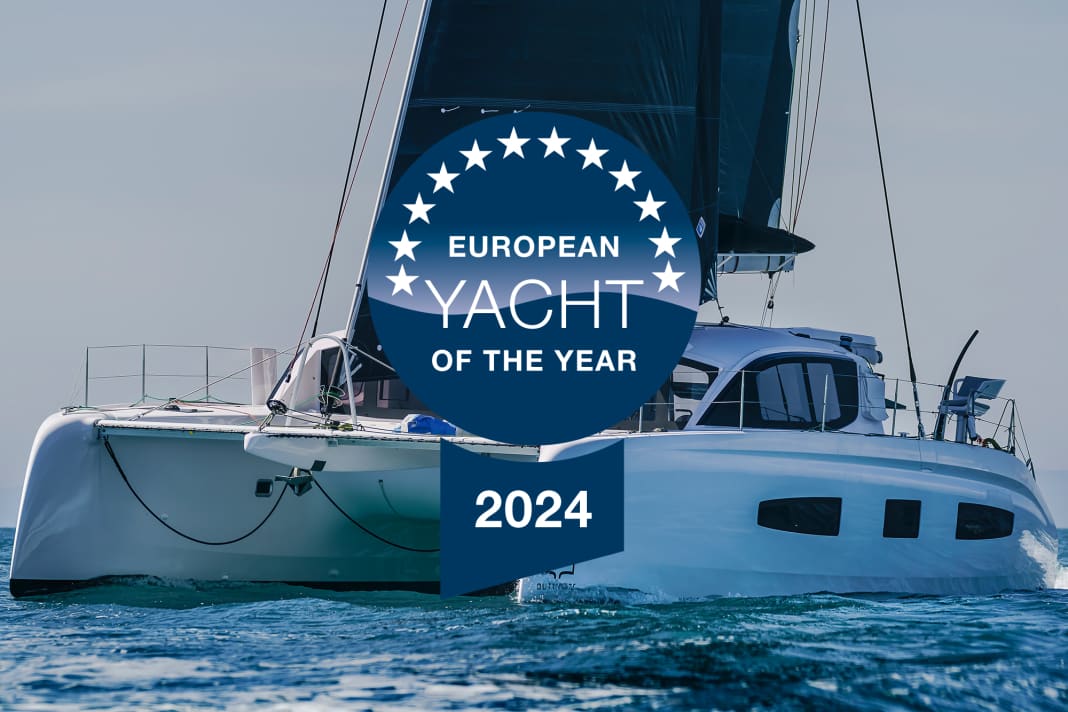





Outremer means overseas in French and is used specifically as a term for the parts of France outside Europe. These include, for example, Guadeloupe and Martinique in the Caribbean, New Caledonia in the South Pacific or La Réunion in the Indian Ocean, to name but a few. Places and areas that are on the bucket list of many long-distance sailors.
Outremer Catamarans builds ocean-going twin-hull boats that allow you to reach these destinations safely and reliably, but also comfortably and, above all, quickly. High performance potential thanks to sporty hull designs, powerful sailing plans and a consistently implemented lightweight construction are part of Outremer's DNA, as is a sophisticated cosiness for high demands and relaxed sea voyages. The shipyard in La Grande-Motte in the south of France has been building exclusive performance cruisers on two hulls since 1984, and more than 300 boats have been launched to date. The brand currently has three models on offer: the Outremer 45, the flagship 55 and the brand new Outremer 52.
High demand for the Outremer 52
Since 2007, Outremer Catamarans has been part of the Grand Large Yachting group, together with other blue water brands such as Allures Yachting, Garcia Yachts and RM Yachts. Gunboat, manufacturer of large and exclusive high-performance catamarans made of carbon fibre, is also part of the shipyard group and produces together with Outremer at the same shipyard site in La Grande-Motte. Naturally, both companies can benefit from each other in terms of purchasing and the exchange of technologies and expertise.
There are currently 72 orders. The shipyard must now further expand its production capacities
However, space on the site is now becoming scarce due to the very good order situation for both brands. With 72 boats of the new Outremer 52 type alone currently on order, capacity is more than exhausted. Grand Large Yachting therefore recently acquired Outremer's main competitor, Marsaudon Composites in Lorient on the Atlantic. Production of the small Outremer 45 is now being relocated there in order to create new production volumes for the 52 in La Grande-Motte and thus reduce delivery times to a sufficient level.
Slim catamaran hulls for good sailing performance
The three current Outremer models show great homogeneity in terms of concept, design and appearance. Typical of the brand are the rather short, dome-shaped deckhouses with large window fronts and a bimini roof that extends far aft. In addition, the hulls of Outremer boats are unusually slim compared to conventional cruising catamarans, with extremely long foredeck sections. And they are fitted with retractable centreboards for good sailing characteristics downwind. The designs for the newer Outremer 55 and 52 models now come from the renowned VPLP Design studio. Previously, catamaran experts Christophe Barreau and Frédéric Neumann collaborated on the designs, and the Outremer 45, the smallest boat, still bears their signature.
Another Outremer trademark is the two helm stations with seats, which are mounted aft on the hulls and are therefore largely free-standing. As a special feature, the shipyard can offer its multihulls with either wheel or tiller steering. Combinations are also possible, such as on the test ship, where a wheel is mounted on the starboard side and a tiller on the port side. This provides more variety for the helmsman, who can steer according to his mood. For a relaxed steering position, benches for two people are bolted to the deck on both sides. This is a great place to sit in the wind when the weather is nice and warm and also very comfortable.
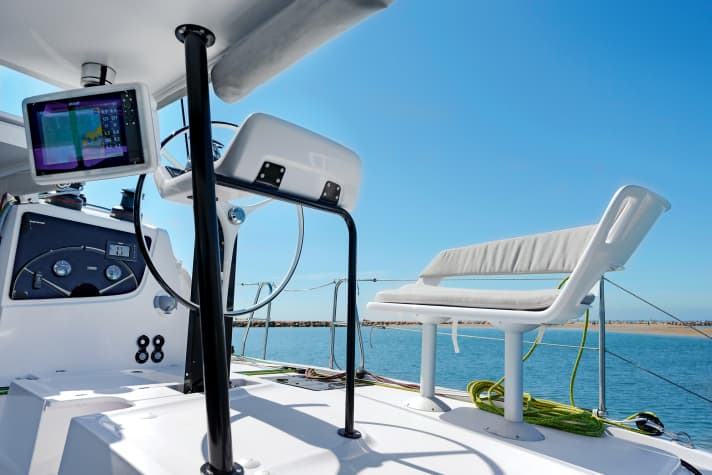
On the Outremer 55 and 52 models, the steering column on the starboard side can also be folded inwards. This allows the helmsman to steer from the sheltered cockpit in rough conditions and bad weather, while still maintaining a good view forwards through the large window fronts in the cabin superstructure. A very well-functioning system and possibly a pioneering idea from Outremer.
Good equipment, many options
The test of the new Outremer 52 takes place in front of the shipyard in La Grande-Motte, with a sea breeze of around 4 Beaufort and only a few waves. The catamaran reaches 7.7 knots on an angle of around 50 degrees to the true wind direction. With the gennaker set and a true wind angle of 100 to 120 degrees, the log quickly climbs into the double-digit range. The performance values are undoubtedly good for a cat of this size, but are also within the expected range, especially in view of the good equipment of the test boat with a significant upgrade of the sail wardrobe.
The basic version of the Outremer 52 is equipped with a self-tacking jib. The overlapping genoa is an option, but is particularly worthwhile for use in the light wind areas of the Mediterranean. However, the shipyard only mounts fixed hoisting points on the coachroof for this, not adjustable ones. Active, sporty sailors would want this. The lightweight carbon rig instead of the standard aluminium mast has the advantage that the boat pitches and lurches significantly less in the waves, which is generally an issue with catamarans. The shipyard can also rig the boat with a rotating carbon fibre profile wing mast on special request, which will undoubtedly provide a considerable increase in performance, but is also challenging to handle and costs around 150,000 euros more.
The shipyard does not cut corners when it comes to the equipment on deck and utilises the highest quality and most select components. In short: only the best is good enough here. Harken and Antal fittings, which appear to be oversized rather than undersized for their application, are part of Outremer's standard equipment ex shipyard. In addition, there are large 60 mm winches for the sheets and halyards with the option of operating them electrically at the touch of a button. The high quality of the attachments, their size and flawless positioning on deck ensure that manoeuvres run smoothly, even without much effort.
However, because the mainsheet and the important traveller on the aft beam are operated from the cockpit and the sheet and halyard winches on the cabin superstructure are not within direct reach of the helmsman, he often has to leave his position at the wheel or tiller when travelling with a small crew or alone.
Outremer favours lightweight construction despite many reinforcements
The centreboards in the hull replace the stub keels normally found on catamarans and limit drift downwind. If you want to utilise the full performance potential of the catamaran and sail actively, you can raise the centreboard fully or partially upwind to reduce drag. In practice, however, the centreboards usually stay down and are only raised to reduce the draft. Incidentally, the centreboards are very light and symmetrically profiled. In the event of damage due to a collision, they can be easily removed and reinstalled in the other hull.
Because the long, slender hulls protrude a long way and the structurally load-bearing platform in between is short in comparison, the construction is exposed to high torsional loads in wind and waves, which can only be absorbed by very robust and rigid structures. Outremer therefore reinforces the hulls built using the vacuum infusion process with solid, continuous longitudinal stringers and laminates strong, torsion-resistant bulkheads with carbon reinforcements. At the same time, the French emphasise a weight-saving design. The entire deck and the cabin superstructure with bimini roof are also manufactured using the vacuum infusion process. The interior is also focussed on weight and lightweight composite materials are used for the furniture.
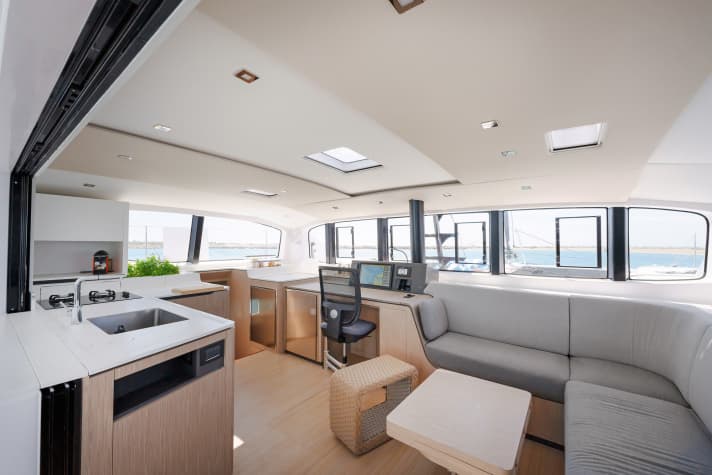
The sporty line costs space
The Outremer 52 can be fitted with either three or four double cabins. Variants are provided for the foredeck in the port hull. As an alternative to the double cabin, it is possible to set up a workshop, an office, a walk-in wardrobe or a cabin with bunk beds for the children. The toilet and washroom as well as the shower are installed in the port hull as two fully insulated bathrooms. This is particularly convenient when both double cabins are occupied.
Nevertheless, in terms of accommodation, the Outremer with its slim hulls cannot stand up to comparison with the very voluminous touring catamarans of the same size. The boats from Lagoon or Fountaine Pajot, for example, offer extended versions with three to six cabins, each with its own wet room, from a hull length of 50 feet.
Top equipment and workmanship
The Outremer 52 is praised for its good, solid build quality. The craftsmanship is impeccable, even down to the smallest detail. The technical installations for the water supply and electricity are also a pleasure. The components are very neatly and clearly installed and are easy to reach. The Outremer also offers excellent ventilation thanks to the numerous windows and hatches in all living areas. Only in the bathroom and especially in the shower room on the port side are the ventilation options limited.
All in all, the Outremer is unrivalled on the market
Buyers must be able to afford around 1.6 million euros for an Outremer 52 in the basic configuration. That's a lot of money, of course, but it's also a lot of money for a boat that is extremely high-quality, comprehensively equipped and almost ready to sail straight from the shipyard. There are also few comparable boats. Brands such as Catana, Dazcat or HH could be mentioned as possible competitors, but they build their boats on completely different foundations and standards. Seen in this light, Outremer serves a niche market, albeit for a demand that is evidently growing.
Measured values Outremer 52
Sailing performance
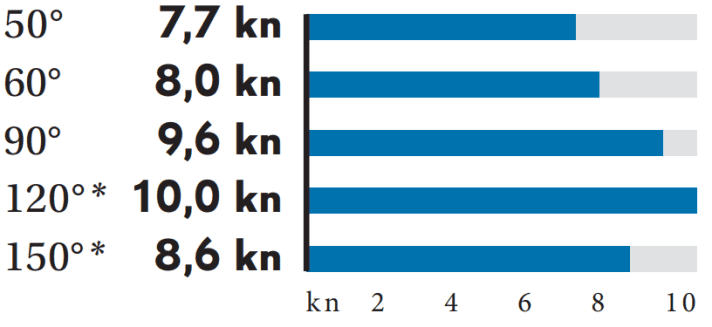
(without drift/current); wind speed: 12 to 15 kn (4 Bft), wave height: approx. 0.5 m * with gennaker
Potential STZ = 5.0

Trimmed for performance. The boat is consistently lightweight and has plenty of sail area
STZ: Dimensionless number. Calculation: 2√S/3√V. The higher the value, the more sail area (S) the ship has in relation to the displacement (V)
Sound pressure
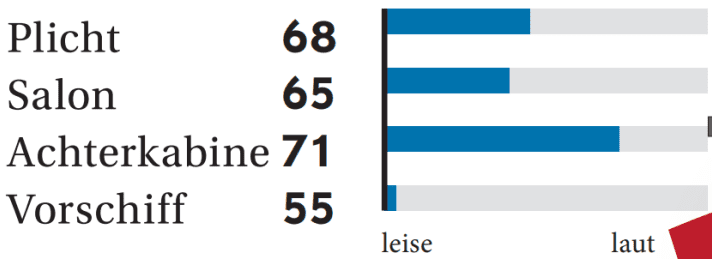
In dB(A), measured at cruising speed (80 % of maximum speed): 8.8 kn, 2,000 min -1
Cockpit dimensions

YACHT review Outremer 52
A cruising machine for active sailors who also want to travel in comfort. With the Outremer 52, long distances are possible, even in light winds. The catamaran is expensive, but not without reason
Design and concept
- + Solid, robust construction
- + Consistent alignment
- + Flexible control positions
- - Only partially suitable for one-handed use
Sailing performance and trim
- + High performance potential
- + Functioning layout
- + High-quality deck equipment
- - Hole points not adjustable
Living and finishing quality
- + Plenty of space in the cabins
- + Beautifully built interior
- + Sophisticated expansion options
- - Ventilation in the wet rooms
Equipment and technology
- + Swords easily catchable
- + Flawless on-board installation
- + Various rig variants
- + Redundant control
Technical data Outremer 52
- Designer: VPLP
- Interior design: Darnet
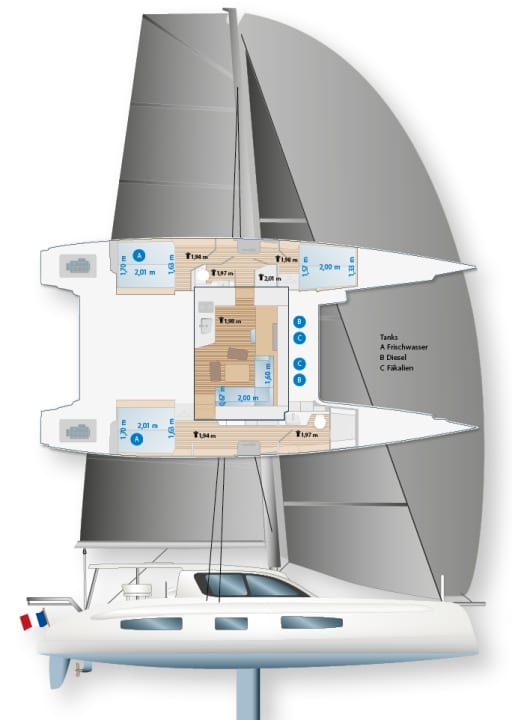
- CE design category: A
- Torso length: 15,72 m
- Overall length (with bowsprit): 16,00 m
- Waterline length: 15,70 m
- Width: 7,89 m
- Draft (swords): 1,07-2,30 m
- Mast height above waterline: 23,05 m
- Theoretical torso speed: 9.6 kn
- Weight: 12,8 t
- Mainsail: 94,5 m²
- Self-tacking jib (standard): 44,6 m²
- Genoa (option): 58,0 m²
- Machine (Volvo): 2x 37 kW/50 hp
- Fuel tanks: 2x 270 litres
- Fresh water tanks: 2x 215 l
- Holding tanks: 2x 75 litres
- Batteries: 2x 90 Ah + 3x 220 Ah
Equipment
Hull and deck construction
Hulls, deck and superstructure built in GRP sandwich with foam core and vinyl ester resin. Full laminate below the waterline
Storage compartments
Lots of large stowage spaces on deck keep things tidy. The sails are best stored in the forepeaks
Cabins/Layout
The forward section of the port hull can also be converted. An office, a workshop or a walk-in wardrobe can be installed here instead of the double cabin. The shipyard is very flexible in this respect
Swords instead of keels
The symmetrical profiles can be fully retracted into the fuselage. This also works well when travelling
Rig
The mast is made of aluminium as standard. A carbon fibre rig is available as an option, which can also be rotated on request
Sail
A simple set of Dacron sails (main and self-tacking jib) is included in the basic equipment ex shipyard
Price
- Base price ex shipyard: 1.642.200 €
Standard equipment included:
Engine, sails, sheets, railing, navigation lights, battery, compass, cushions, galley/cooker, bilge pump, toilet, fire extinguisher, electric cooler, holding tank with suction, draining and clear sailing handover
For an extra charge:
Anchor with chain € 2,560, fender/mooring € 3,510, antifouling € 6,390
- Price ready to sail: 1.654.660 €
- Comfort price: 1.710.495 €
- Guarantee/against osmosis: 2/2 years
As of 11/23. You can find out how the prices shown are defined here!
Shipyard and distribution
Outremer Catamarans, 726 Avenue Robert Fages, 34280 La Grande-Motte (France) www.catamarans-outremer.com

